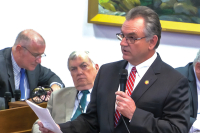Presnell calls emissions testing a ‘sham’
 The Great Smoky Mountains are known across the world for their beauty and the unique bluish haze produced in large part by local vegetation, but if N.C. Rep. Michele Presnell, R-Burnsville, has her way, the Smokies may soon become a lot smokier.
The Great Smoky Mountains are known across the world for their beauty and the unique bluish haze produced in large part by local vegetation, but if N.C. Rep. Michele Presnell, R-Burnsville, has her way, the Smokies may soon become a lot smokier.
In North Carolina, vehicles owned by residents of 48 counties, including Haywood County, must pass an on-board diagnostic emissions inspection before their registrations can be renewed.
There are exceptions for vehicles manufactured before 1996, for vehicles that utilize diesel fuel and for vehicles licensed under the farm rate, but the vast majority of Haywood County cars and trucks undergo the test, which is designed to limit the production of air pollutants like hydrocarbons, carbon monoxide, nitrous oxides, sulfurs, smoke and soot — all of which carry negative consequences for individual health and the environment.
House Bill 169, the true-to-its-name “Regulatory Reduction Act of 2016” is sponsored by Presnell and House Majority Leader Mike Hager, R-Rutherford, and included a provision to remove several counties, including Haywood, from the list of areas where motor vehicle emissions are regulated.
Vehicular emissions regulation has been in practice in the United States in one form or another since the late 1950s after numerous state, federal, and local studies suggested that automobiles were a significant contributor to smog and pollution.
Crankcase emission standards were enacted in California in 1961, and by 1968 tailpipe emissions were also being monitored there. By the mid-70s, catalytic converters were in widespread use on new vehicles across the United States, leaving only older model cars and trucks still on the road to spew elevated levels of pollutants into the atmosphere.
Related Items
However, problems with air quality continued to persist, as evidenced by a 1999 L.A. Times story titled, “Air Quality Problems Raising Concern in Great Smoky Mountains Park.” In that story, scientists shed light on why, exactly, air stagnation persisted after emissions regulations began to take hold.
Light winds, upwind regional growth and fossil fuels contributed to a 21 percent increase in sulfur dioxide emissions in the region from 1985 to 1994, as did emissions from the more than 10 million vehicles visiting the park annually.
But by 2010, Georgia’s Clean Air Force — an enhanced vehicle emissions inspection program working in conjunction with Georgia’s Environmental Protection Division — revealed in a study that “68 percent of all respondents believe [their] program is worthwhile overall with the top reason being because it helps metro Atlanta’s air quality.”
Additionally, in 2013, the National Parks Conservation Association cited a Colorado State University study indicating that air quality in the Smoky Mountains was “headed in the right direction.”
Even last June, SMN reported that ozone pollution was down 36 percent, particulate pollution had been cut in half, and the view on the haziest days now extends nearly four times as far as it did in 1998. Jim Renfro, air quality program manager for the park, said that compared to 10 or 15 years ago, air quality is “significantly better.”
Presnell’s apparently not convinced.
“People in my district cannot afford to replace parts on their cars that cost hundreds of dollars that do little to nothing to improve emissions,” Presnell said in an email sent on June 21. “My constituents are tired of paying good money for useless government-mandated testing.”
Even as continually tightening emissions standards — standards of the kind that recently led automaker Volkswagen to “cheat” on its emissions reporting — began to produce measurable improvements in air quality, it remains a problem, especially in the nation’s most polluted national park.
“Obviously we have a problem with air pollution,” said Avram Friedman, executive director of the Canary Coalition, an air quality watchdog group that has broadened its scope to include larger environmental issues. “Automobiles are a relatively small contributor to that problem. Nonetheless, I think it’s important as old cars are phased out — maintenance has to be performed on these cars to ensure they remain above standards.”
According to the National Park Service website, “air pollution is shrinking scenic views, damaging plants, and degrading high elevation streams and soils in the Great Smoky Mountains. Even human health is at risk. Most pollution originates outside the park and is created by power plants, industry, and automobiles.”
In its initial incarnation, H169 would have removed Haywood County from the list of counties required to perform vehicle emissions testing, but after the one-page bill passed the House, the Senate added 19 more pages to it (including a provision to repeal current restrictions on sales of pet turtles, among other things), and removed Haywood County from the list without consulting Presnell.
“If H169 is heard in committee or on the floor, I will push to have Haywood County added back into the bill,” she said via email June 27. “In its current form, I will vote to not concur with changes made by the Senate. If the bill goes into conference and Haywood County is added back into the bill, I will vote to concur.”









